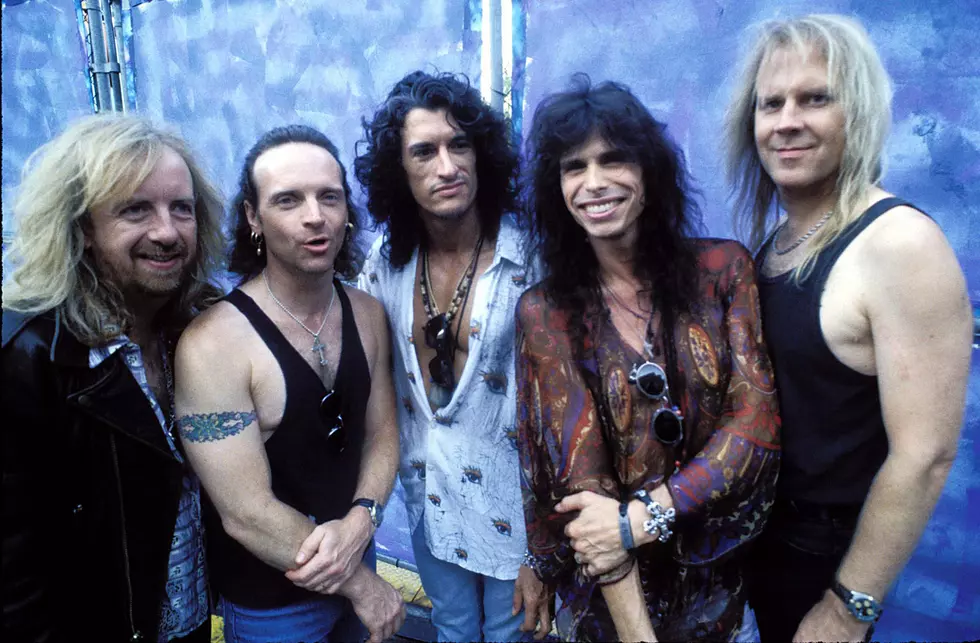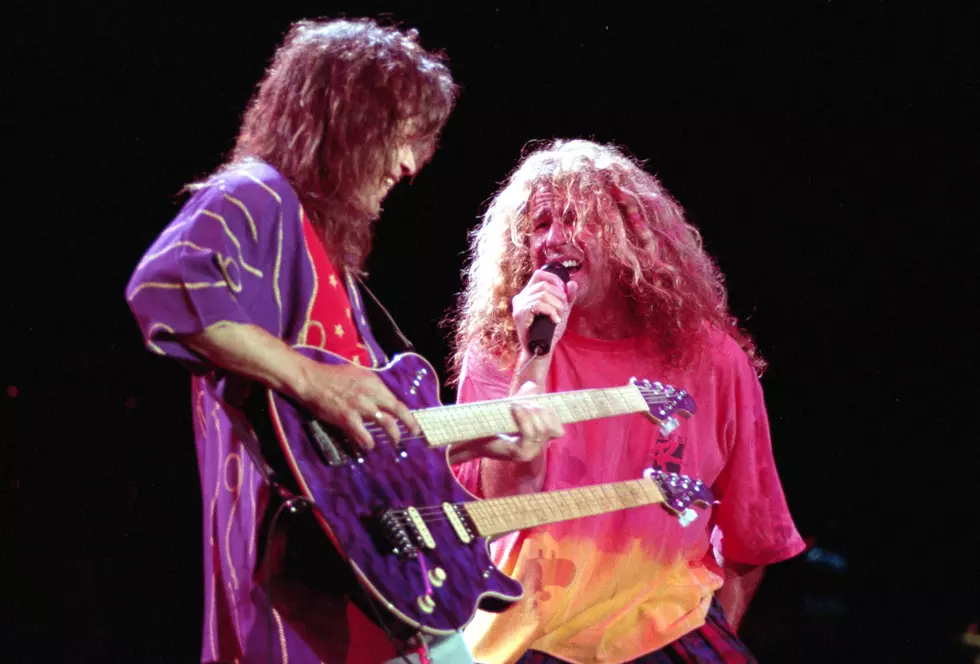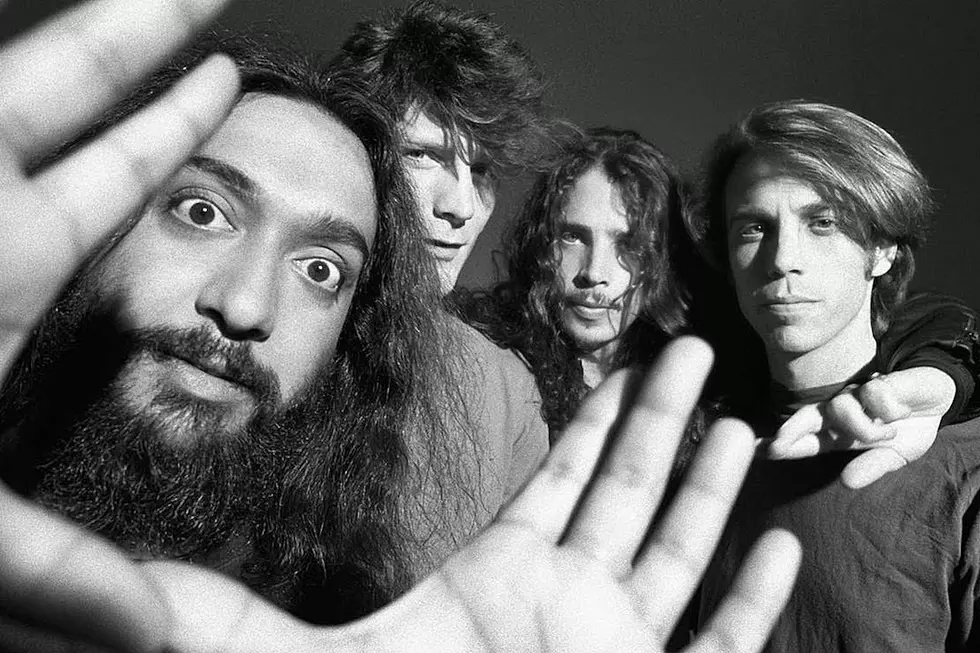Top 30 American Classic Rock Bands of the ’90s

30. Motley Crue
Albert Ortega, Getty Images
30. Motley Crue
Let’s be honest: Motley Crue spent most of the ’90s in decline. It’s only because they started from such a lofty perch that they didn’t fall off this list. “Primal Scream” started the decade off strongly 1991, but fans didn’t give the band’s powerful but Vince Neil-less 1994 self-titled album a fair shot. And when the singer did return for 1997’s ‘Generation Swine,’ his bandmates couldn’t agree on a clear musical direction, resulting in a muddled, ill-fitting record. Still, even during this downturn, the band sold tons of concert tickets, and it wouldn’t be long before 2000’s ‘New Tattoo’ marked a solid return to the classic sound.

29. Aerosmith
Jeff Kravitz, Getty Images
29. Aerosmith
The one-two late-’80s punch of ‘Permanent Vacation’ and ‘Pump’ sent Aerosmith into the new decade flying high. Partially thanks to some star-powered videos and a clutch of memorable ballads, they maintained that lofty altitude with 1993’s ‘Get a Grip.’ Their newly polished formula finally started to show some signs of rust on 1997’s ‘Nine Lives,’ but the album still sold more than 2 million copies in the States and spawned a memorable single and video with “Pink.”

28. Kiss
Mick Hutson, Getty Images
28. Kiss
Kiss succeeded in three distinct ways during the ’90s. At the start of the decade, they teamed up with producer Bob Erzin to record the best album of their non-makeup era, ‘Revenge.’ A few years later, they put the greasepaint back on and reunited with founding members Ace Frehley and Peter Criss for a successful tour. Perhaps most importantly, their influence on new rock bands in the ’90s became clear. Acts such as Nirvana, Pearl Jam and Foo Fighters all revealed themselves as Kiss fans; they’d even cover the band’s songs on record and onstage.

27. Hole
Kevin Mazur, Getty Images
27. Hole
Hole’s first album, ‘Pretty on the Inside,’ arrived in 1991, but it wasn’t until 1994’s ‘Live Through This’ that they became a great band. The record came out a week after the death of frontwoman Courtney Love’s husband, Kurt Cobain, and its legend immediately grew as rumors surfaced that he had a huge hand in shaping the songs. Whatever the case may be, the dozen tracks found on ‘Live Through This’ are among alt-rock’s toughest from the era, sung with spitting exuberance by Love, who became a tabloid mainstay following the album’s release. It would take four years before the Los Angeles-based Hole regrouped for another excellent record, the pop-polished ‘Celebrity Skin,’ which included assistance by another ’90s rock luminary: Smashing Pumpkins’ Billy Corgan.

26. Wilco
Austin Nelson
26. Wilco
Jeff Tweedy quickly moved Wilco beyond the sound of his seminal alt-country band Uncle Tupelo, exploring less rootsy, more personal and frankly weirder musical territories. That helped Wilco to become one of the ’00s’ best bands, but not before establishing themselves in the previous decade with 1996’s multilayered ‘Being There’ and 1999’s increasingly mind-bending ‘Summerteeth.’

25. Pantera
George De Sota, Getty Images
25. Pantera
As quickly as Metallica abdicated their “coolest and most important metal band” throne, Pantera were there to snap it up with the one-two punch of 1990’s ‘Cowboys From Hell’ and 1992’s ‘Vulgar Display of Power.’ Guitarist Dimebag Darrell and singer Phil Anselmo became a new generation’s Page and Plant (or Van Halen and Roth), nearly as famous for their hard-partying ways as for their groundbreaking music. The group’s classic lineup last performed together in 2001 and Dimebag was tragically killed in 2004. Surviving members Phil Anselmo and Rex Brown eventually recruited guitarist Zakk Wylde and drummer Charlie Benante for a reunion tour in 2023.

24. Flaming Lips
Warner Bros.
24. Flaming Lips
The Oklahoma-bred Flaming Lips had been kicking around for a dozen years when they released their eighth album, ‘Zaireeka,’ in 1997. (They also had a minor radio hit in 1993 with the endearingly goofy “She Don’t Use Jelly.”) That four-LP masterwork – which included different parts of the same album spread out over a quartet of discs that were meant to be played simultaneously – opened up a whole new era for the band, which transformed from an experimental post-punk group into a neo-psychedelic prog outfit for 1999’s ‘The Soft Bulletin’ and set them up as one of the new century’s most adventurous artists.

23. Sleater-Kinney
Kill Rock Stars
23. Sleater-Kinney
One of the last great punk bands of the 20th century, Sleater-Kinney reached their apex with 1997’s raging ‘Dig Me Out.’ They never sold a lot and weren’t on a major record label, but that only added to their considerable street cred.

22. Pavement
Gie Knaeps, Getty Images
22. Pavement
Pavement launched their career at the start of the ’90s with a series of EPs that led to their debut album, ‘Slanted and Enchanted,’ in 1992. It remains one of the cornerstone records of the indie-rock movement, a low-fi classic that’s equal parts art project and rock ‘n’ roll deconstruction piece. For 1994’s ‘Crooked Rain, Crooked Rain’ they went the opposite direction and made a streamlined record that name-dropped Smashing Pumpkins and Stone Temple Pilots and sounded like an era-ready record of hook-stuffed alt-rock. The California band managed only one Top 10 Modern Rock hit (“Cut Your Hair” from ‘Crooked Rain’), but its five LPs – the last arrived in 1999 – influenced an entire generation of indie rockers that came of age in the new millennium.

21. Anthrax
Ian Dickson, Getty Images
21. Anthrax
Although it’s becoming more of a forgotten footnote as the band’s history rolls on, Anthrax’s John Bush era lasted for more than a decade and gave birth to four well-regarded albums. Even though they were still on a commercial rise on 1990’s Joey Belladonna-fronted ‘Persistence of Time,’ creative disagreements between the singer and his bandmates led to his departure and an ambitious new musical direction for the Bush-fronted lineup. No less an authority than Metallica’s James Hetfield praised “Only” from 1993’s ‘Sound of White Noise’ as “a perfect song.”

20. Pixies
Steve Pyke, Getty Images
20. Pixies
Boston’s Pixies released their two best albums – ‘Surfer Rosa’ and ‘Doolittle’ – at the tail end of the ’80s, but they were still on a creative high as the ’90s dawned. They released two more albums almost immediately: 1990’s ‘Bossanova’ and 1991’s ‘Trompe le Monde.’ And then it was all over. They’d reunite and make more albums starting in 2014, but their legend was built on those first four albums and debut EP. At first glance those two ’90s LPs may appear to be the sound of the band running its course, but their influence on the new decade is immeasurable, starting with Nirvana, whose breakthrough and cultural-shifting ‘Nevermind’ was released on the same day as the Pixies’ final record.

19. Foo Fighters
Capitol Records
19. Foo Fighters
When you think of the ‘90s, you probably think of Dave Grohl’s other band, but the latter half of the decade established Foo Fighters as one of rock’s premier acts. From the ashes of Nirvana, Grohl emerged with the Foos’ 1995 self-titled debut album. While that LP proved the drummer had the chops to be a frontman, it was the next album, 1997’s ‘The Colour and the Shape,’ that elevated the band to headliner status. “Monkey Wrench,” “My Hero” and “Everlong” became alt-rock radio mainstays, with MTV putting each respective video in regular rotation. By this point, Grohl had fleshed out the lineup with guitarist Pat Smear, bassist Nate Mendel and drummer Taylor Hawkins, taking Foo Fighters from a fledgling solo idea to a full-fledged rock giant. The group would close the decade with another celebrated album, the Grammy-winning ‘There’s Nothing Left to Lose.’

18. Weezer
DGC
18. Weezer
Weezer’s first concert took place in 1992, a show alongside Keanu Reeves’ band Dogstar. Things don’t get more ‘90s than that. Two years later, the music world was turned on its head with the release of Weezer’s self-titled debut LP, commonly referred to as the Blue Album. Produced by the Cars’ Ric Ocasek, the LP was stuffed full of alt-rock earworms, including “My Name Is Jonas,” “Undone (The Sweater Song),” “Say It Ain’t So” and “Buddy Holly.” The latter track would become an MTV mainstay, with its ‘Happy Days’-themed video scoring four VMAs. Even though Weezer’s 1996 LP ‘Pinkerton’ would be a commercial failure compared to the Blue Album, it offered more complex songwriting and deeper lyrics than its predecessor and has become a fan favorite. Weezer closed the decade amid a hiatus, though they would return in 2001 with the Green Album.

17. Sonic Youth
Michael Levine, DCG Records
17. Sonic Youth
The alternative revolution gave pretty much every indie artist a chance to be a star, even if most of their time in the spotlight was temporary. ‘Daydream Nation’ (from 1988) is Sonic Youth’s sprawling masterpiece, but they kicked off the ’90s with two of the best and most accessible albums of their long, and occasionally difficult, career: ‘Goo’ in 1990 and ‘Dirty’ two years later. The records yielded two Top 10 Modern Rock radio hits for the band – “Kool Thing” and “100%,” respectively – which were no small feat considering the New York City band’s no wave roots and noisy, experimental nature. ‘Washing Machine,’ from 1995, sorta returned them to those roots.

16. Jane’s Addiction
Frank Micelotta, Getty Images
16. Jane’s Addiction
Somewhere between the glamorous excess of ‘80s hair metal and the drudgery of ‘90s alt-rock are Jane’s Addiction, a group whose eclectic style skirted standard labeling. Even though the band released its first first studio LP in 1988, it was during the ‘90s that the group ascended to the upper echelon of rock. Their 1990 LP, ‘Ritual de lo Habitual,’ featured “Been Caught Stealing” and “Stop!,” both of which hit No. 1 on the Modern Rock chart. Frontman Perry Farrell quickly became a Gen-X icon, famously founding Lollapalooza in 1991. The festival – originally conceived as a farewell tour for Jane’s Addiction – became a landmark event in alternative music. Although the band spent more than half the decade broken up (before reuniting in 1997), its influence on the era’s musical landscape was unquestioned.

15. The Black Crowes
Columbia
15. The Black Crowes
Black Crowes started the decade with a debut that felt like a throwback in the best possible way, punching a hole in an over-produced era and filling it with gritty blues-rock and simmering southern soul. They built on those successes with a sophomore album that established their voices in ways critics of the Black Crowes’ old-school approach simply couldn’t ignore. By the beginning of a new decade, things were falling apart. But the Black Crowes had already made their mark by then.

14. Alice in Chains
Jeffrey Mayer, Getty Images
14. Alice in Chains
Hailed as grunge pioneers, Alice in Chains leaned toward the darker side of the genre, with a style dramatically influenced by heavy metal. The band’s debut album, 1990’s ‘Facelift,’ has been cited as a turning point in ‘90s music, the first grunge LP to make a dent in the mainstream. But success didn’t come overnight. ‘Facelift’ took a while to find an audience, and it wasn’t until MTV moved the video for “Man in a Box” into heavy rotation that sales took off. Further releases during the decade included the quadruple-platinum ‘Dirt’ (1992) and Grammy-nominated self-titled album (1995), with “Rooster,” “Would?” and “Heaven Beside You” among their hits. Meanwhile, an iconic performance on ‘MTV Unplugged’ cemented the group as one of the era’s most talented acts. But things weren’t going well behind the scenes. Singer Layne Staley battled depression and heroin addiction, issues that were exacerbated following the drug overdose of his former fiancee. By 1996, Staley had become a recluse, recoiling from the limelight and avoiding his bandmates. Even though Alice in Chains didn’t officially break up, the band went on hiatus, with other members pursuing outside projects through the end of the decade. Staley died of a drug overdose in 2002.

13. Green Day
Kevin Winter, Getty Images
13. Green Day
Emerging from the Bay Area, Green Day exploded into the mainstream in 1994 with their major-label debut LP, ‘Dookie.’ Powered by the hit singles “Longview,” “Welcome to Paradise,” “Basket Case” and “When I Come Around” the album sold more than 10 million copies, ranking among the best-selling rock releases of the decade. Green Day’s success helped usher in a wave of ‘90s punk, opening doors for bands such as the Offspring, Blink-182 and Rancid. Green Day followed up the success of ‘Dookie’ with ‘Insomniac’ (1995) and ‘Nimrod’ (1997), both of which would earn double-platinum sales. The latter LP also featured “Good Riddance (Time of Your Life),” the heartstring-tugging acoustic track that quickly became a hit. The tune became the go-to soundtrack for high-school graduations and proms in the ‘90s; it later was memorably featured in the series finale of ‘Seinfeld.’

12. Van Halen
Tim Mosenfelder, Getty Images
12. Van Halen
Van Halen may have been the last major classic-rock act to release an album that wasn’t affected by the grunge revolution. ‘For Unlawful Carnal Knowledge,’ from 1991,was released three months before Nirvana’s ‘Nevermind’ and spawned a trio of hit singles. When Van Halen returned to a vastly changed musical landscape four years later with ‘Balance,’ it was with short haircuts, beards and more serious lyrical subject matter. It wasn’t the most natural fit, but the album did well enough to keep the band near the forefront of the rock scene for most of the decade. After that, the band made more headlines than hits, splitting up with singer Sammy Hagar, then hiring and firing both David Lee Roth and Gary Cherone, before the decade ended.

11. Rage Against the Machine
Epic
11. Rage Against the Machine
Before rap-rock became mainstream, and before the term “nu-metal” was coined, there was Rage Against the Machine. Loud, provocative and politicized, the Los Angeles group was proudly one of the most defiant voices in music. The distinctive delivery of singer Zach de la Rocha, coupled with the dynamic guitar prowess of Tom Morello, gave Rage an unparalleled ferocity. Their incendiary lyrics confronted everything from racism to corporate greed, rallying fans to fight back against the powers that be. Across three ‘90s albums – their self-titled debut (1992), ‘Evil Empire’ (1996) and ‘The Battle of Los Angeles’ (1999) – Rage released some the decade’s most explosive songs, including “Killing in the Name,” “Bulls on Parade,” “Guerrilla Radio” and “Sleep Now in the Fire.” The band also delivered one of the most memorable performances of Woodstock ‘99, tearing through a set of hits before controversially burning the U.S. flag during the final song.

10. Guns N’ Roses
Kevin Mazur, Getty Images
10. Guns N’ Roses
Four years after their debut ‘Appetite for Destruction’ almost single-handedly destroyed hair metal and revitalized rock ‘n’ roll, Guns N’ Roses kicked off the new decade with the highly anticipated ‘Use Your Illusion’ albums. With two-and-a-half hours of music spread out over a pair of double albums, the records gave the band plenty of rocket fuel to burn over the next few years. As the band played to massive crowds around the world, generating headlines, controversy and sometimes riots, the albums spawned eight singles. Even complex, cinematic songs like “November Rain” and “Estranged” became huge hits. But the band was also falling apart. Drummer Steven Adler was axed during the ‘Ilusion’ sessions, and founding members Izzy Stradlin, Duff McKagan and Slash were all gone by 1995. It would be another 13 years before frontman Axl Rose re-emerged with a radically new GNR lineup and the ‘Chinese Democracy’ album.

9. Nine Inch Nails
Sean Gardner, Getty Images
9. Nine Inch Nails
As the ‘90s saw a splintering of subgenres within the rock world, industrial music climbed into the mainstream. The leader of this sound was Nine Inch Nails, headed by dynamic frontman Trent Reznor, who often was a one-man band in the studio. Mixing the power of hard rock with the studio wizardry of electronic artists, Nine Inch Nails forged an influential trail throughout the decade. The crown jewel of their releases remains 1994’s ‘The Downward Spiral,’ an LP packed with heavy-hitting tracks like “Closer,” “March of the Pigs” and “Hurt.” NIN continued to be a force throughout the ‘90s, appearing on the Reznor-produced soundtrack to ‘Natural Born Killers’ and earning another multi-platinum release with ‘The Fragile.’ ‘Time’ magazine even named Reznor one of its most influential Americans, noting the artist “wields the muscular power of industrial rock not with frat-boy swagger but with a brooding, self-deprecating intelligence.”

8. Metallica
Clay Mclachlan, Getty Images
8. Metallica
Metallica made the sudden and startling leap from World’s Most Popular Metal Band to Biggest Rock Band on the Planet with their self-titled 1991 album. Abandoning their complex thrash sound in favor of a simpler hard-rock approach (heard on songs like “Enter Sandman”) angered some longtime fans. But for every ‘Master of Puppets’ loyalist who walked out the door, hundreds of new listeners stormed in to take their place. Half a decade later, the band expanded on the approach of the Black Album by incorporating Southern rock, blues and country on the successful ‘Load’ and ‘Reload’ albums.

7. Tom Petty and the Heartbreakers
MCA
7. Tom Petty and the Heartbreakers
For the second decade in a row, Tom Petty’s solo success overshadowed what he accomplished with his longtime band the Heartbreakers. The music they made together – particularly 1991’s ‘Into the Great Wide Open’ and “Last Dance With Mary Jane” from 1993’s ‘Greatest Hits’ – certainly enhanced their overall legacy. But even Petty realized that 1994’s solo ‘Wildflowers’ – home to “You Don’t Know How it Feels” and “It’s Good to Be King” – was something extra special. “He told me ‘Wildflowers’ scares him, because he’s not really sure why it’s as good as it is,” producer Rick Rubin explained on his ‘Broken Record’ podcast. “He loves it, but it’s not like he can turn that on again.”

6. Red Hot Chili Peppers
Warner Bros.
6. Red Hot Chili Peppers
After establishing their funk-rock prowess in 1989 on the strength of the ‘Mother’s Milk’ LP, Red Hot Chili Peppers ascended to another level with their 1991 album ‘Blood Sugar Sex Magik.’ The release featured now classic tracks like “Give it Away,” “Breaking the Girl” and “Suck My Kiss.” Still, it was an anthemic ode to addiction, “Under the Bridge,” that brought the band mainstream adoration, peaking at No. 2 on the Billboard Hot 100. The band’s lineup would fluctuate – most notably with guitarist John Frusciante departing in 1992 and replaced by Dave Navarro, only to have Frusciante return in 1998. Nevertheless, the massive success of further releases ‘One Hot Minute’ (from 1995) and ‘Californication’ (1999) would solidify the Chili Peppers among ‘90s rock elite.

5. Smashing Pumpkins
Caroline
5. Smashing Pumpkins
The Smashing Pumpkins released their debut album, ‘Gish,’ in 1991. Within four years, they logged a No. 1 LP and were one of the biggest bands in the world. Frontman Billy Corgan wrapped his love of ’70s classic rock in a metallic sheen that reflected fans’ shift to alternative music. ‘Siamese Dream,’ from 1993, is their masterpiece, but 1995’s double ‘Mellon Collie and the Infinite Sadness’ piled on the ambition and hooks. By the time 1998’s toned-down ‘Adore’ arrived, Corgan was ready to steer the Chicago band in different directions, just as the alt revolution was taking its final stand.

4. Soundgarden
A&M Records
4. Soundgarden
The first grunge band to sign with a major label, Soundgarden were among the genre’s trailblazers. Their 1991 album ‘Badmotorfinger’ would engage a national audience thanks to such classic tracks as “Outshined” and “Rusty Cage.” Still, it was 1994’s ‘Superunknown” that elevated the band to the Mt. Rushmore of grunge acts, buoyed by the brooding “Black Hole Sun.” While the fledgling genre was blessed with several iconic frontmen – including Kurt Cobain and Eddie Vedder – there may have been no better grunge voice than Chris Cornell’s. With a four-octave range and a powerful delivery, he could go from guttural growl to soaring falsetto all within the same tune. Although the band would break up in 1997 (before reuniting in 2010), Soundgarden earned two Grammy Awards and sold more than 15 million albums worldwide during the ‘90s.

3. Pearl Jam
Epic
3. Pearl Jam
Eddie Vedder and company burst into the mainstream in 1991 on the strength of their debut LP, ‘Ten.’ The album – which featured such timeless grunge classics as “Even Flow,” “Alive” and “Jeremy” – kicked off a prolific decade for Pearl Jam. The group released five studio LPs and one live album before the dawn of the new millennium, all of which earned platinum sales or better. The band toured relentlessly, leaving a wake of frenzied fans in every city it visited. Demand for Pearl Jam tickets was so high that they took extra efforts to circumvent scalpers, hoping to make it easier for fans to see their shows. A well-publicized battle with Ticketmaster furthered this cause. A rivalry between Pearl Jam and fellow grunge headliners Nirvana quickly emerged, though the severity of the contention has been debated. Still, for a generation of rock fans, picking a side between Pearl Jam and Nirvana was akin to choosing between the Beatles and the Rolling Stones.

2. R.E.M.
Chris Carroll, Getty Images
2. R.E.M.
Smaller, more personal albums made them underground darlings. Then R.E.M. started to move away from that with 1987’s ‘Document.’ The follow-up, 1989’s ‘Green,’ simply confirmed things: This wasn’t going to be the underground’s little secret anymore. R.E.M. were poised for big things in the decade to follow, and they lived up to every element of that promise. Everything got bigger: the sound, the themes, the stages, the sales. R.E.M. belonged to the world now.

1. Nirvana
DGC
1. Nirvana
It’s impossible to look back at ‘90s rock music without spotlighting Nirvana. With more than 50 million albums sold worldwide in the decade – including more than 10 million copies of ‘Nevermind’ sold in the U.S. – the band emerged from Seattle to become one of the biggest in music. Still, Nirvana’s impact goes far beyond the stats. As poster children of the grunge movement, the group led what was arguably the last seismic shift within the genre. Their influence was felt throughout pop culture – on MTV, in fashion, with hairstyles and more. These antiheroes were suddenly the idols of teens and young adults the world over, thrust into the spotlight as the voice of Gen X. Their tenure was short – Nirvana released only three studio LPs, a live album and a compilation before Kurt Cobain ended his life on April 5, 1994. But Nirvana’s impact was so powerful that it continues to reverberate throughout popular music to this day.
News
Jennifer Lopez spotted flying in ECONOMY after diva took financial hit following tour cancellation
Jennifer Lopez spotted flying in ECONOMY after diva took financial hit following tour cancellation Jennifer Lopez was spotted flying commercial in Europe after taking some financial hits and cancelling her tour amid her marital woes with Ben Affleck. The 54-year-old actress was seen sitting…
Prince Harry and William won’t inherit Princess Diana’s home as surprising heir gets the property
Prince Harry and William won’t inherit Princess Diana’s home as surprising heir gets the property Princess Diana grew up on the Althorp Estate and was laid to rest at her childhood home, but her sons Prince Harry and Prince William…
Jennifer Lopez hides her wedding finger AGAIN as she departs her hotel in Paris after husband Ben Affleck ditched his ring – as divorce rumours ramp up
Jennifer Lopez hides her wedding finger AGAIN as she departs her hotel in Paris after husband Ben Affleck ditched his ring – as divorce rumours ramp up Jennifer Lopez appeared to hide her wedding finger for a second time on Monday as she…
BILLION DOLLAR GIRL From two private jets to multiple mansions – inside Taylor Swift’s incredible fortune as she becomes a billionaire at 34../
BILLION DOLLAR GIRL From two private jets to multiple mansions – inside Taylor Swift’s incredible fortune as she becomes a billionaire at 34.. The low-key couple were spotted boarding a private jet in Rhode Island on Sunday, September 15. In…
Social networks are buzzing about Meghan Markle. At the age of 42, she just announced shocking news on social media, making her family and fans happy for her
Social networks are buzzing about Meghan Markle. At the age of 42, she just announced shocking news on social media, making her family and fans happy for her The Duchess of Sussex expressed her joy at being able to dedicate…
Fans think Taylor Swift hinted at Travis Kelce’s onstage Eras Tour cameo with new ring: ‘Deffo an Easter egg’
Fans think Taylor Swift hinted at Travis Kelce’s onstage Eras Tour cameo with new ring: ‘Deffo an Easter egg’ They’re two Ts in a pod. Taylor Swift wore a brand-new ring during her Sunday Eras Tour performance at London’s Wembley…
End of content
No more pages to load











